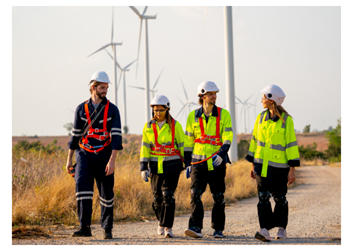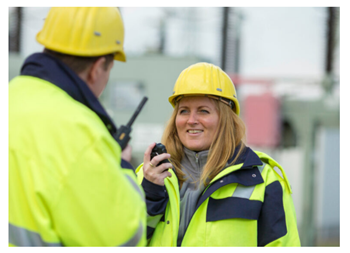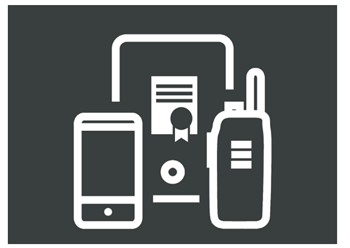Improving safety and communication for lone workers in renewable energy
Since the energy crisis in 2022, there has been a significant increase in investments in renewable energy. This has resulted in a higher capacity for renewable energy production and an increase in the number of people working in this sector. While there have been improvements in safety measures, there has been little progress in addressing work-related health issues. According to the Health and Safety Executive, the renewable energy sector has one of the highest rates of occupational ill health in the economy. The industry’s own data reveals that sickness absence per worker has been on the rise in recent years, standing at around 75% higher than the average across all sectors. The scale of the problem In the UK, 2020 marked a milestone as renewable energy made up the majority of electricity generation for the first time, with 43%* coming from wind, solar, bioenergy, and hydro sources. This led to increased investment in the sector, resulting in the growth of employment in the low carbon and renewable energy economy. As the sector continues to expand, more workers are retraining and refocusing their careers in this field, highlighting the importance of health and safety training. Lone workers in the renewable energy industry face unique challenges when it comes to safety and communication. These workers often operate in remote locations and can be exposed to hazardous conditions, which can be heightened when working alone such as slips, trips, and falls, medical emergencies, aggression from the public, lack of oversight, and communication difficulties. These factors can all increase the risk of accidents or incidents occurring. Communication and supervision are crucial aspects of ensuring the safety. Without supervision, individuals may not have access to necessary guidance to prevent injury, and it may be challenging to garner assistance quickly in the event of an accident. More than 500 incidents were reported for onshore wind farms in the UK in 2022, according to SafetyOn’s report. To address these risks, employers must prioritise health and safety training for their employees, including risk assessment, use of personal protective equipment, emergency response protocols, and communication procedures. Don Mackay, SafetyOn Chair and chief technical officer at EDF Renewables, said: “The tragic loss of a life in our industry focuses our shared determination to minimise hazards, improve practices and make our workplaces safe.” Regular check-ins and monitoring systems should be implemented to ensure the well-being of lone workers, and clear lines of communication should be established for emergencies. By implementing these measures, employers can mitigate the risks associated with lone working in the renewable energy sector and safeguard the health and safety of their employees. The Importance of safety and communication for renewable energy employees In the renewable energy industry, lone workers face unique risks and challenges that require specific safety measures. It is not only a legal obligation but also an ethical responsibility for businesses to ensure the well-being of these workers. Prioritising safety and communication is crucial as it allows for quick response in emergencies and facilitates seamless coordination. Legal obligation: as per regulations and laws, businesses are required to provide a safe working environment for their employees. By implementing safety measures and ensuring effective communication, businesses can fulfil their legal obligations and protect their workers from potential hazards. Ethical responsibility: beyond legal requirements, prioritising the safety and well-being of lone workers is an ethical responsibility. By investing in safety solutions and communication systems, businesses demonstrate their commitment to worker welfare and overall operational excellence. Rapid response in emergencies: working alone in the renewable energy industry can be inherently dangerous. In case of an accident, prompt response is critical to mitigate further harm and provide necessary medical assistance. Effective communication systems with emergency alerts and fall notifications enable lone workers to quickly notify the relevant authority or their colleagues about any emergencies. This ensures that help can be dispatched immediately, potentially saving lives and minimising the impact of accidents. Seamless coordination: in addition to safety, communication plays a vital role in facilitating seamless coordination among employees. When working on renewable energy projects, individuals often need to collaborate with their team members, supervisors, or remote experts. Timely and efficient communication ensures that tasks are executed accurately, potential issues are addressed promptly, and overall productivity is enhanced. With the right communication tools and systems in place, lone workers can stay connected and receive necessary guidance, further improving their performance and work outcomes. Improving Safety and Communication for lone workers in renewable energy In this section, we will explore how communication devices and software can support safety policies for lone workers in the renewable energy industry. The solutions Radiocoms recommend combine advanced, resilient wearable devices with real-time data analytics and reliable network connectivity to provide an all-encompassing support system. Features include: 1. GPS tracking allowing employers to be monitored in real-time, ensuring their safety and enabling a prompt response in an emergency. 2. Devices equipped with emergency alert features to allow lone workers to quickly notify authorities or colleagues of emergencies. 3. Two-way communication capabilities for easy communication with other local team members, supervisors, and remote experts. 4. Real-time data analytics to provide valuable insights into lone worker activities, health, and environmental conditions, allowing for proactive safety measures. By recognising the importance of safety and communication for lone workers in the renewable energy industry, businesses can create a positive work environment that promotes employee well-being, reduces risks, and ultimately leads to operational excellence. Investing in advanced safety solutions and communication systems not only fulfils legal obligations but also showcases a commitment to worker welfare, earning the trust and loyalty of both employees and stakeholders. User case – ScottishPower Renewables Renewable energy company ScottishPower Renewables turned to Radiocoms, to support the monitoring and protect their employees while they work alone. MOTOTRBO’s lone worker and man down solution is particularly valuable in the renewable energy sector. Emergency situations may make it difficult for workers to seek help. Traditional communication methods, such as calling out or making a phone call can often present numerous challenges, a MOTOTRBO DP4801e enabled with man down detects impacts, falls, and inactivity automatically, offering an affordable yet robust automated solution to address these concerns. By connecting their DP4801e radios to SmartPTT software ScottishPower can effectively monitor and organise their teams, ensuring the safety of their lone workers and at-risk staff. Alongside the safety of lone workers, the solution also provides a full history of the users’ device such as when they entered and departed a locationVisit the Radiocoms Systems Limited website for more information on Improving safety and communication for lone workers in renewable energy






